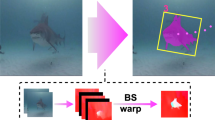Abstract
This paper analyses the automatic fish segmentation problem in turbulent waters. To this end, a SOM neural network is used to detect fishes in images from an underwater camera system built in a vertical slot fishway, an hydraulic structure built in obstructions in rivers to allow the upstream migration of fishes.
This technique allows the study of real fish behavior and may help to understand biological variables and swimming limitations of the fish species in high speed environments.
This knowledge, may be used to replace traditional techniques such as direct observation or placement of sensors on the specimens, which are impractical or affect the fish behavior.
To test the proposed technique, a ground true dataset was designed with experts and a series of assays have been performed where the results obtained with the proposed technique were compared with different segmentation techniques.
Access this chapter
Tax calculation will be finalised at checkout
Purchases are for personal use only
Preview
Unable to display preview. Download preview PDF.
Similar content being viewed by others
References
Puertas, J., Pena, L., Teijeiro, T.: An Experimental Approach to the Hydraulics of Vertical Slot Fishways. Journal of Hydraulics Engineering 130 (2004)
Rajaratnam, N., Vinnie, G.V.D., Katopodis, C.: Hydraulics of Vertical Slot Fishways. Journal of Hydraulic Engineering 112, 909–927 (1986)
Tarrade, L., Texier, A., David, L.: Topologies and measurements of turbulent flow in vertical slot fishways. Hydrobiologia 609, 177–188 (2008)
Wu, S., Rajaratma, N., Katopodis, C.: Structure of flow in vertical slot fishways. Journal of Hydraulic Engineering 125, 351–360 (1999)
Dewar, H., Graham, J.: Studies of tropical tuna swimming performance in a large water tunnel – Energetics. Journal of Experimental Biology 192, 13–31 (1994)
Blake, R.W.: Fish functional design and swimming performance. Journal of Fish Biology 65, 1193–1222 (2004)
Photographic and acoustic tracking observations of the behavior of the grenadier Coryphaenoides (Nematonorus) armatus, the eel Synaphobranchus bathybius, and other abyssal demersal fish in the North Atlantic Ocean. Marine Biology 112, 1432–1793 (1992)
Steig, T.W., Iverson, T.K.: Acoustic monitoring of salmonid density, target strength, and trajectories at two dams on the Columbia River, using a split-beam scaning system. Fisheries Research 35, 43–53 (1998)
Deng, Z., Richmond, M.C., Guest, G.R., Mueller, R.P.: Study of Fish Response Using Particle Image Velocimetry and High-Speed, High-Resolution Imaging. US Department of Energy, Technical Report (2004)
Duarte, S., Reig, L., Oca, J., Flos, R.: Computerized imaging techniques for fish tracking in behavioral studies. European Aquaculture Society (2004)
Chambah, M., Semani, D., Renouf, A., Courtellemont, P., Rizzi, A.: Underwater color constancy enhancement of automatic live fish recognition. IS&T Electronic Imaging, SPIE (2004)
Petrell, R.J., Shi, X., Ward, R.K., Naiberg, A., Savage, C.R.: Determining fish size and swimming speed in cages and tanks using simple video techniques. Aquacultural Engineering 16, 63–84 (1997)
Morais, E.F., Campos, M.F.M., Padua, F.L.C., Carceroni, R.L.: Particle filter-based predictive tracking for robust fish count. In: Brazilian Symposium on Computer Graphics and Image Processing, SIBGRAPI (2005)
Clausen, S., Greiner, K., Andersen, O., Lie, K.-A., Schulerud, H., Kavli, T.: Automatic segmentation of overlapping fish using shape priors. In: Scandinavian Conference on Image Analysis (2007)
Chuang, M.-C., Hwang, J.-N., Williams, K., Towler, R.: Automatic fish segmentation via double local thresholding for trawl-based underwater camera systems. In: IEEE International Conference on Image Processing, ICIP (2011)
Spampinato, C., Chen-Burger, Y.-H., Nadarajan, G., Fisher, R.: Detecting, Tracking and Counting Fish in Low Quality Unconstrained Underwater Videos. In: Int. Conf. on Computer Vision Theory and Applications, VISAPP (2008)
Lines, J.A., Tillett, R.D., Ross, L.G., Chan, D., Hockaday, S., McFarlane, N.J.B.: An automatic image-based system for estimating the mass of free-swimming fish. Computers and Electronics in Agriculture 31, 151–168 (2001)
Rodriguez, A., Bermudez, M., Rabuñal, J.R., Puertas, J., Dorado, J., Balairon, L.: Optical Fish Trajectory Measurement in Fishways through Computer Vision and Artificial Neural Networks. Journal of Computing in Civil Engineering 25, 291–301 (2011)
Cheng, H.D., Jiang, X.H., Sun, Y., Wang, J.: Color image segmentation: advances and prospects. Pattern Recognition 34, 2259–2281 (2001)
Kohonen, T.: Self-organized formation of topologically correct feature maps. Biol. Cybernet. 43, 59–69 (1982)
Moya, F., Herrero, V., Guerrero, G.: La aplicación de redes neuronales artificiales (RNA) a la recuperación de la información. SOCADI Yearbook of Information and Documentation 1998(2), 147–164 (1998)
Yilmaz, A., Javed, O., Shah, M.: Object Tracking: A Survey. ACM Computing Surveys 38 (2006)
Verikas, A., Malmqvist, K., Bergman, L.: Color image segmentation by modular neural networks. Pattern Recognition Letters 18, 175–185 (1997)
Dong, G., Xie, M.: Color clustering and learning for image segmentation based on neural networks. IEEE Transactions on Neural Networks 16, 925–936 (2005)
Egmont-Petersen, M., Ridder, D., Handels, H.: Image processing with neural networks-a review. Pattern Recognition 35, 2279–2301 (2002)
Cristea, P.: Application of Neural Networks In Image Processing and Visualization. In: GeoSpatial Visual Analytics, pp. 59–71. Springer, Netherlands (2009)
Author information
Authors and Affiliations
Editor information
Editors and Affiliations
Rights and permissions
Copyright information
© 2013 Springer-Verlag Berlin Heidelberg
About this paper
Cite this paper
Rodriguez, A., Rabuñal, J.R., Bermudez, M., Puertas, J. (2013). Detection of Fishes in Turbulent Waters Based on Image Analysis. In: Ferrández Vicente, J.M., Álvarez Sánchez, J.R., de la Paz López, F., Toledo Moreo, F.J. (eds) Natural and Artificial Computation in Engineering and Medical Applications. IWINAC 2013. Lecture Notes in Computer Science, vol 7931. Springer, Berlin, Heidelberg. https://doi.org/10.1007/978-3-642-38622-0_42
Download citation
DOI: https://doi.org/10.1007/978-3-642-38622-0_42
Publisher Name: Springer, Berlin, Heidelberg
Print ISBN: 978-3-642-38621-3
Online ISBN: 978-3-642-38622-0
eBook Packages: Computer ScienceComputer Science (R0)




